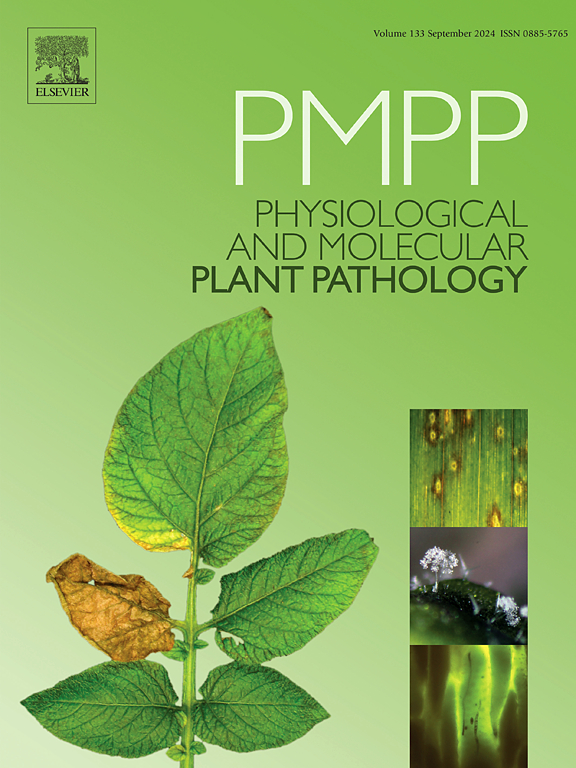travancorense:一种新的真菌病原体,引起印度喀拉拉邦travancorense的叶斑和枯萎病
IF 2.8
3区 农林科学
Q2 PLANT SCIENCES
引用次数: 0
摘要
西高止山脉是著名的生物多样性热点地区,具有巨大的生物和地理意义。喀拉拉邦位于该地区,拥有以印度主要森林类型为特色的多种森林。它有利的气候条件支持各种微生物群的蓬勃生长。在巡回调查期间,在喀拉拉邦Peechi-Vazhani野生动物保护区附近的喀拉拉邦森林研究所药用植物园内采集了一种表现出叶斑病和枯萎病症状的野生咖啡植物咖啡树(Rubiaceae)。采用标准组织分离方法分离出与该病相关的真菌病原体,并确定其致病性。根据形态培养特征和多基因序列分析(ITS、LSU和tub2区)对真菌病原体进行鉴定。分析结果表明,该叶片病原菌属travancorense副盘孢菌。系统发育分析进一步表明,P. travancorense形成了一个独立的分支,与P. roridum和P. breviseta密切相关。然而,在形态上与这些物种不同,它的分生孢子和分生孢子更大。此外,花椒中没有刚毛,而花椒和花椒中有刚毛。本研究首次记录了新型真菌病原菌特拉凡哥(P. travancorense)对特拉凡哥的影响。这些发现强调了加强疾病监测和制定可持续、有效的管理战略以减轻其影响的必要性,从而支持印度喀拉拉邦的保护工作和作物恢复力。本文章由计算机程序翻译,如有差异,请以英文原文为准。

Paramyrothecium travancorense: A novel fungal pathogen causing leaf spots and blights on Coffea travancorensis in Kerala, India
The Western Ghats, a renowned biodiversity hotspot, holds immense biological and geographical significance. Kerala, located in this region, harbors diverse forests featuring major Indian forest types. Its favorable climatic conditions support the thriving growth of a wide variety of microbiota. During roving survey, Coffea travancorensis (Rubiaceae), a wild coffee plant exhibiting symptoms of leaf spot and blight disease was collected from medicinal plants garden of Kerala Forest Research Institute, near the Peechi-Vazhani Wildlife Sanctuary, Kerala. The fungal pathogen associated with the disease was isolated using the standard tissue isolation method and its pathogenicity was confirmed. Identification of the fungal pathogen was performed based on morpho-cultural characteristics and multigene sequence analysis (ITS, LSU, and tub2 regions). The analysis revealed that the leaf-pathogenic fungus belongs to Paramyrothecium travancorense. Phylogenetic analysis further showed that P. travancorense formed a distinct clade, separated from the closely related species, P. roridum and P. breviseta. However, morphologically, P. travancorense differs from these species as its conidiophores and conidia are larger. Additionally, setae are absent in P. travancorense, whereas they are present in P. roridum and P. breviseta. This study represents the first record of the novel fungal pathogen P. travancorense on C. travancorensis. The findings highlight the need for enhanced disease monitoring and the development of sustainable, effective management strategies to mitigate its impact, thereby supporting conservation efforts and crop resilience in Kerala, India.
求助全文
通过发布文献求助,成功后即可免费获取论文全文。
去求助
来源期刊
CiteScore
4.30
自引率
7.40%
发文量
130
审稿时长
38 days
期刊介绍:
Physiological and Molecular Plant Pathology provides an International forum for original research papers, reviews, and commentaries on all aspects of the molecular biology, biochemistry, physiology, histology and cytology, genetics and evolution of plant-microbe interactions.
Papers on all kinds of infective pathogen, including viruses, prokaryotes, fungi, and nematodes, as well as mutualistic organisms such as Rhizobium and mycorrhyzal fungi, are acceptable as long as they have a bearing on the interaction between pathogen and plant.

 求助内容:
求助内容: 应助结果提醒方式:
应助结果提醒方式:


